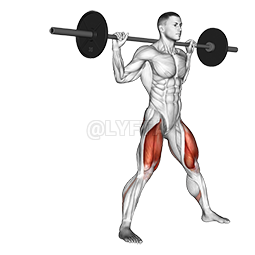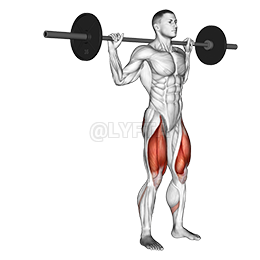
Barbell Banded Squat
Exercise Profile
Related Exercises:
Introduction to the Barbell Banded Squat
The Barbell Banded Squat is a dynamic strength training exercise that combines the benefits of resistance and weight training to enhance lower body strength, stability, and power. This exercise is ideal for athletes, fitness enthusiasts, and individuals looking to intensify their regular squat routine or improve their functional fitness. Incorporating the Barbell Banded Squat into your workout regimen can help increase muscle activation, improve lifting mechanics, and provide a progressive resistance that can result in a more effective and challenging workout.
Performing the: A Step-by-Step Tutorial Barbell Banded Squat
- Position the barbell across your shoulders, standing with your feet shoulder width apart, toes pointing slightly outward, and knees in line with your toes.
- Slowly lower yourself into a squat position, keeping your chest up and your back straight, ensuring your knees don't go past your toes.
- Pause at the bottom of the squat, then push through your heels to stand up straight again, maintaining the tension in the resistance band.
- Repeat this movement for your desired number of repetitions, ensuring to keep the resistance band taut throughout the entire exercise.
Tips for Performing Barbell Banded Squat
- Maintain Proper Form: Keep your feet shoulder-width apart, toes slightly pointed out. As you lower your body, push your knees out against the band. This will help engage your glutes and protect your knees. Make sure your back is straight and your chest is up. Avoid rounding your back, which is a common mistake and can lead to injury.
- Depth of the Squat: Aim to lower your body until your thighs are parallel to the floor or slightly lower. Avoid half-squats as they don't fully engage the muscles and can put unnecessary strain on your knees.
- Controlled Movement: Perform the exercise in a controlled manner. Avoid rushing the movement or using momentum to lift the weight.
Barbell Banded Squat FAQs
Can beginners do the Barbell Banded Squat?
Yes, beginners can do the Barbell Banded Squat exercise. However, it is important to start with a light weight or even just the barbell to ensure proper form and avoid injury. It's also beneficial to have a trainer or experienced person guide through the process to ensure the form and technique are correct. The resistance band is used to increase difficulty, so beginners may want to start without it and add it as they become more comfortable and stronger.
What are common variations of the Barbell Banded Squat?
- Barbell Squat with Resistance Bands: This version involves attaching resistance bands to the barbell, which increases the difficulty as you ascend and helps to improve your explosive strength.
- Box Squat with Barbell: This involves squatting down until your buttocks touch a box or bench, which can help to improve your form and depth.
- Barbell Overhead Squat: In this variation, the barbell is held overhead throughout the movement, which challenges your balance and mobility, as well as your lower body strength.
- Barbell Squat with Pause: This involves holding the squat at the bottom of the movement for a few seconds before pushing back up, which can help to increase your strength at the weakest part of the squat.
What are good complementing exercises for the Barbell Banded Squat?
- The Walking Lunges exercise complements the Barbell Banded Squat by focusing on each leg individually, thus improving the symmetry and balance, which is important for maintaining proper form during squats.
- The Glute Bridge is another exercise that pairs well with the Barbell Banded Squat as it targets the glutes and hip flexors, muscles that are essential for generating power during the upward phase of the squat.
Related keywords for Barbell Banded Squat
- Barbell Squat Workout
- Quadriceps Strengthening Exercises
- Thigh Toning with Barbell
- Banded Barbell Squats
- Barbell Exercises for Lower Body
- Squatting with a Barbell
- Quadriceps and Thigh Workout
- Resistance Band Barbell Squat
- Strength Training for Quadriceps
- Lower Body Barbell Workout










